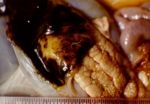Difference between revisions of "Trichinelloidea"
Jump to navigation
Jump to search
m |
|||
| Line 20: | Line 20: | ||
There are just three genera of veterinary importance: | There are just three genera of veterinary importance: | ||
| − | + | #''Trichuris'' (the whipworms) | |
| − | + | #''Capillaria'' | |
| − | + | #''Trichinella'' | |
| − | |||
| − | |||
| − | |||
== ''Trichuris'' Species == | == ''Trichuris'' Species == | ||
| − | *The whipworms have a stout posterior end and a long narrow neck, which is superficially inserted into the caecal mucosa | + | *The whipworms have a stout posterior end and a long narrow neck, which is superficially inserted into the caecal mucosa |
| − | *The infective stage is the embryonated egg. | + | *Eggs are brown, barrel-shaped, with a plug at either end, and can survive for up to 12 years |
| − | *The life-cycle is direct | + | *The infective stage is the embryonated egg. |
| − | *After the egg is swallowed, the larva initially forms a mucosal nodule before emerging into the lumen | + | *The life-cycle is direct |
| − | + | *After the egg is swallowed, the larva initially forms a mucosal nodule before emerging into the lumen | |
== ''Capillaria'' == | == ''Capillaria'' == | ||
| − | *Similar to ''Trichuris'', but the difference between anterior and posterior ends of the body is not so pronounced | + | *Similar to ''Trichuris'', but the difference between anterior and posterior ends of the body is not so pronounced |
| − | *Some species have direct life-cycles, others use intermediate or transport hosts | + | *Some species have direct life-cycles, others use intermediate or transport hosts |
| − | *Species have different predilection sites | + | *Species have different predilection sites |
| − | *Of greatest importance in birds, species do occur in the urinary bladder and liver of cats and dogs | + | *Of greatest importance in birds, although species do occur in the urinary bladder and liver of cats and dogs |
| − | |||
== ''Trichinella'' == | == ''Trichinella'' == | ||
| − | *This is known as the "worm that thinks its a virus" | + | *This is known as the "worm that thinks its a virus" |
| − | *It is | + | *It is an important zoonosis |
| − | + | *It is covered in greater detail | |
Revision as of 12:54, 9 January 2009
| This article is still under construction. |
|
|
The common feature of members of this group is that the oesophagus is a column of doughnut-shaped cells. They are only distantly related to the other nematode groups and so drugs developed primarily for controlling strongyle and ascarid worms are often less effective against these.
There are just three genera of veterinary importance:
- Trichuris (the whipworms)
- Capillaria
- Trichinella
Trichuris Species
- The whipworms have a stout posterior end and a long narrow neck, which is superficially inserted into the caecal mucosa
- Eggs are brown, barrel-shaped, with a plug at either end, and can survive for up to 12 years
- The infective stage is the embryonated egg.
- The life-cycle is direct
- After the egg is swallowed, the larva initially forms a mucosal nodule before emerging into the lumen
Capillaria
- Similar to Trichuris, but the difference between anterior and posterior ends of the body is not so pronounced
- Some species have direct life-cycles, others use intermediate or transport hosts
- Species have different predilection sites
- Of greatest importance in birds, although species do occur in the urinary bladder and liver of cats and dogs
Trichinella
- This is known as the "worm that thinks its a virus"
- It is an important zoonosis
- It is covered in greater detail
- Capillaria aerophila in respiratory disease of cats and dogs
- Trichinella in myositis





